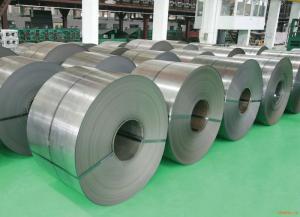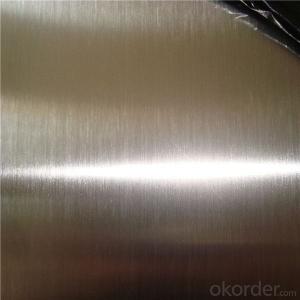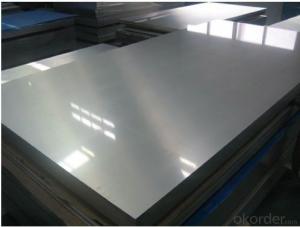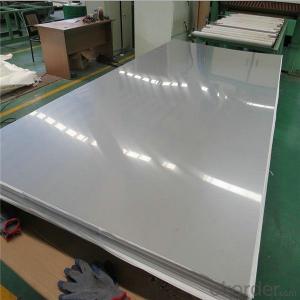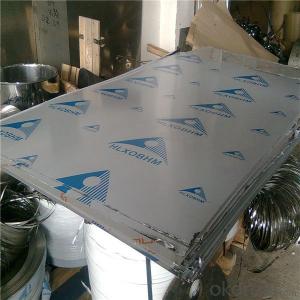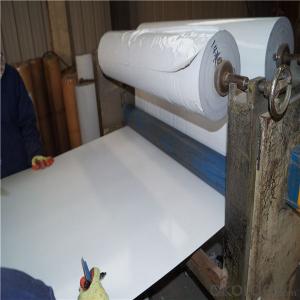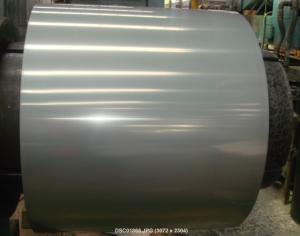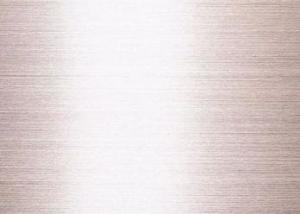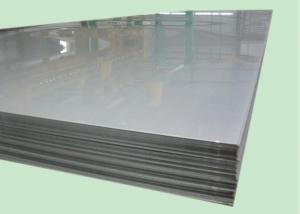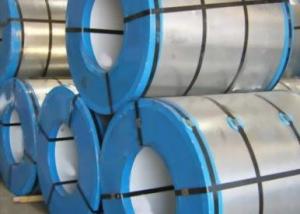STAINLESS STEEL PLATE/SHEET 304 BA PVC ON SIDE
- Loading Port:
- Shanghai
- Payment Terms:
- TT OR LC
- Min Order Qty:
- 50 m.t.
- Supply Capability:
- 10000 m.t./month
OKorder Service Pledge
OKorder Financial Service
You Might Also Like
Stainless Steel Plate
Specification:304,BA
PVC one side
Type | 2B/BA/6K stainless steel plate/sheet 304 304L |
Size/thinckness | 0.2mm-2.0mm |
Widthness | ≤1000mm or as your request |
Length | 1000mm-3000mm or as your requirement |
Standard | ASTM, AISI,GB, JIS etc |
Material | 201,202,304,304L,310s,316L,904L,316,321,410,420,430,etc |
Application range | Foodstuff, Gas, metallurgy, biology, electron, chemical, petroleum, boiler, nuclear energy, Medical equipment, fertilizer etc |
Packaging | export standard picking or as customers' requirement |
Delivery time | about 45 days working days after receiving the deposit |
Productivity | 2000 tons/month |
Chemical composition of Some Common Designations:
| Material No. | Main elements contained: maximum percentage(%) | ||||||
| C | Mn | P | S | Si | Gr | Ni | |
| 201 | 0.1 | 8.5-10 | 0.09 | 0.03 | 0.75 | 15.0-16.0 | 0.8-1.2 |
| 202 | 0.08 | 7.0-8.0 | 0.07 | 0.01 | 0.7 | 14.5-15.5 | 4.0-4.2 |
| 304 | 0.08 | 2.00 | 0.045 | 0.03 | 0.75 | 18.0-20.0 | 8.0-10.5 |
| 304L | 0.03 | 2.00 | 0.035 | 0.03 | 1.00 | 17.0-19.0 | 8.0-11.0 |
| 309 | 0.20 | 2.00 | 0.040 | 0.03 | 1.00 | 12.0-15.0 | 22.0-24.0 |
| 309S | 0.08 | 2.00 | 0.045 | 0.03 | 1.00 | 12.0-15.0 | 22.0-24.0 |
| 310 | 0.15 | 2.00 | 0.20 | 0.15 | 1.00 | 23.0-26.0 | 17.0-20.0 |
| 310S | 0.08 | 2.00 | 0.035 | 0.03 | 1.00 | 19.0-22.0 | 24.0-26.0 |
| 316 | 0.08 | 2.00 | 0.045 | 0.03 | 1.00 | 16.0-18.0 | 10.0-14.0 |
| 316L | 0.03 | 2.00 | 0.045 | 0.03 | 1.00 | 16.0-18.0 | 12.0-15.0 |
- Q: Are stainless steel strips suitable for HVAC systems?
- Indeed, HVAC systems find stainless steel strips to be a fitting choice. Stainless steel, known for its resistance to corrosion, can endure the harsh conditions and elevated temperatures typically encountered in HVAC systems. Its durability and longevity, coupled with its exceptional heat transfer properties, make it an ideal material. Given its strength, corrosion resistance, and capacity to uphold cleanliness and hygiene, stainless steel strips are frequently utilized in fabricating HVAC system components such as ductwork and heat exchangers. Moreover, the ease of cleaning and maintenance associated with stainless steel strips contributes to their widespread use in HVAC applications.
- Q: Are stainless steel strips non-magnetic?
- Yes, stainless steel strips are generally non-magnetic. However, the magnetic properties of stainless steel can vary depending on the specific alloy and its composition. The most common types of stainless steel, such as 304 and 316, are non-magnetic in their annealed state, meaning they do not attract or hold a magnetic charge. This makes them suitable for a wide range of applications where magnetism is not desired. However, some stainless steel alloys, such as ferritic grades, can exhibit magnetic properties due to their higher iron content. It is important to consider the specific type of stainless steel when determining its magnetic properties.
- Q: Can stainless steel strips be used in the production of kitchen sinks?
- Yes, stainless steel strips can be used in the production of kitchen sinks. Stainless steel is a popular material choice for kitchen sinks due to its durability, corrosion resistance, and ability to maintain a clean and hygienic surface. Stainless steel strips can be shaped and welded to create the various components of a kitchen sink, such as the basin and drainboard. The strips can also be polished to achieve a smooth and sleek finish. Additionally, stainless steel strips offer ease of maintenance and long-lasting performance, making them a suitable choice for kitchen sink production.
- Q: Are stainless steel strips suitable for chemical pipes?
- Yes, stainless steel strips are suitable for chemical pipes. Stainless steel is highly resistant to corrosion, making it an ideal material for piping systems that handle chemicals. It has excellent resistance to a wide range of chemicals, including acids, alkalis, and solvents. Stainless steel's resistance to corrosion is due to the presence of chromium, which forms a protective oxide layer on the surface of the metal, preventing further corrosion and ensuring the longevity of the pipes. Additionally, stainless steel is known for its high strength and durability, making it capable of withstanding the high pressures and temperatures often associated with chemical processing. Overall, stainless steel strips are a reliable and suitable choice for chemical pipes.
- Q: Can stainless steel strips be used in wastewater treatment plants?
- Yes, stainless steel strips can be used in wastewater treatment plants. Stainless steel is a highly durable and corrosion-resistant material, making it suitable for use in environments with high moisture and chemical exposure, such as wastewater treatment plants. Stainless steel strips can be utilized in various applications within the plant, including piping, tanks, screens, and other equipment. Additionally, stainless steel's resistance to bacterial growth and ease of cleaning makes it a hygienic choice for use in the treatment of wastewater.
- Q: What are the different finishes available for stainless steel strips?
- There are several different finishes available for stainless steel strips, including brushed, mirror, satin, and bead blasted finishes. These finishes provide various levels of shine, texture, and aesthetic appeal, allowing for versatility in different applications and design preferences.
- Q: What are the different types of edges for stainless steel strips?
- Various types of edges can be used in the manufacturing of stainless steel strips, each fulfilling a specific purpose and application. Some commonly used types of edges for stainless steel strips include: 1. Mill Edge: This edge, which is produced during the manufacturing process, is the most common type. It has a slightly rounded or curved shape, making it suitable for general applications. 2. Slit Edge: By slitting the stainless steel strip into narrower widths, this type of edge is achieved. It is typically a straight edge, although it may have slight burrs or roughness. Industries that don't require precision and tight tolerances often use slit edges. 3. Deburred Edge: To eliminate any burrs or roughness on the slit edge, a deburring process is applied. This results in a smooth and rounded edge, ensuring safety and preventing damage during handling. 4. Rolled Edge: Rolling the stainless steel strip produces this type of edge, which is smooth and rounded. Rolled edges are commonly used in applications where safety and aesthetics are important, such as in architectural and decorative uses. 5. Beveled Edge: A beveled edge refers to an angled or sloping cut made on the edge of the stainless steel strip. It is typically used in applications that require welding or joining, as the bevel facilitates better weld penetration and joint strength. 6. Sheared Edge: This type of edge is achieved by cutting the stainless steel strip with a sharp blade. Sheared edges may have slight variations and irregularities but are suitable for applications where precision is not critical. 7. Custom Edges: Depending on specific requirements, stainless steel strips can be manufactured with custom edges. These edges are tailored to meet the unique needs of the application, such as special chamfers, grooves, or profiles. When selecting the appropriate type of edge, it is crucial to consider the intended use and requirements of the stainless steel strip. The choice of edge can impact the functionality, appearance, and compatibility of the strip with different manufacturing processes.
- Q: What are the common lengths of stainless steel strips?
- The common lengths of stainless steel strips can vary depending on the specific application and industry. However, there are some standard lengths that are commonly available. These lengths typically range from 12 inches (30.48 cm) to 144 inches (365.76 cm) or 12 feet (3.66 meters). Stainless steel strips are often sold in standardized sizes to accommodate various uses, such as construction, manufacturing, or fabrication. These lengths allow for easy handling and transportation while providing flexibility for cutting or shaping as per the requirements of the project or application. It's important to note that custom lengths can also be obtained by requesting special orders from suppliers or metal fabricators. These custom lengths are often utilized when specific dimensions are needed to fit certain machinery, equipment, or architectural designs.
- Q: What are the different types of surface textures for stainless steel strips?
- There are several different types of surface textures available for stainless steel strips, each offering unique characteristics and aesthetic appeal. Some common types of surface textures for stainless steel strips include: 1. No.1 Finish: This is the most basic and commonly used stainless steel surface texture, characterized by a dull, rough, and non-reflective appearance. It is produced by hot rolling the stainless steel strip and is typically used for industrial applications where appearance is not a priority. 2. No.2B Finish: This surface texture is also achieved through hot rolling, followed by a cold rolling process and annealing. It exhibits a smooth, reflective appearance with a slightly duller finish compared to No.1. No.2B finish is widely used in various applications, including kitchen appliances, architectural components, and decorative uses. 3. No.4 Finish: Also known as satin or brushed finish, this texture is achieved by mechanically polishing the stainless steel strip using abrasive materials. It results in a consistent, smooth, and linear appearance with a low reflectivity. No.4 finish is commonly used for decorative purposes in the architectural and interior design industries. 4. BA (Bright Annealed) Finish: This surface texture is obtained by subjecting the stainless steel strip to a bright annealing process, which helps improve its corrosion resistance and give a highly reflective, mirror-like finish. The BA finish is often used in applications where a high level of reflectivity and aesthetics are desired, such as automotive trim, decorative items, and appliances. 5. No.8/Mirror Finish: This is the highest quality and most reflective surface texture available for stainless steel strips. It is achieved through a multi-step process of grinding, polishing, and buffing the strip, resulting in a flawless, mirror-like appearance. The No.8 finish is commonly used in high-end architectural projects, luxury goods, and decorative applications. These are just a few examples of the various surface textures available for stainless steel strips. The choice of texture depends on the specific requirements of the application, including aesthetics, functionality, and durability.
- Q: Can 111 stainless steel strips be used in the oil and gas industry?
- Yes, 111 stainless steel strips can be used in the oil and gas industry.
Send your message to us
STAINLESS STEEL PLATE/SHEET 304 BA PVC ON SIDE
- Loading Port:
- Shanghai
- Payment Terms:
- TT OR LC
- Min Order Qty:
- 50 m.t.
- Supply Capability:
- 10000 m.t./month
OKorder Service Pledge
OKorder Financial Service
Similar products
Hot products
Hot Searches
Related keywords
